ScopeLocker Air
Endoscope Drying Cabinet
Facilitating endoscope drying,
protection and storage.
Learn More
Inadequate drying of endoscope channels is a possible cause of microbial proliferation during storage.2 A continuous flow of air through endoscope channels helps remove moisture needed for bacterial growth.
The ScopeLocker Air endoscope drying cabinet features two independent filtered air flow cycles that distribute air:
- Around the outside of endoscopes
- Through endoscope channels
Removes 99.97% of air particulates up to 0.3µm
Removes 99.97% of air particulates up to 0.3µm
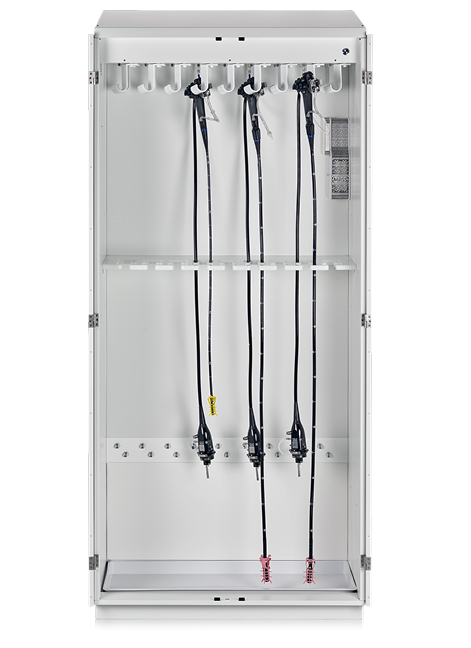
meet association standards?
Drying: (12.5) Dry all accessible endoscope channels with pressure-regulated instrument air or HEPA-filtered air in accordance with the manufacturer’s IFU. Dry all accessible channels for a minumum of 10 minutes. If moisture is still observed, extend drying time until no moisture is visible.3
The endoscope and its components should be dried after completion of the cleaning and disinfection process. Flexible endoscopes with channels should be dried for a minimum of 10-minutes with pressure-regulated forced instrument air or a minimum of HEPA-filtered air.
Flexible Endoscope Drying Cabinet Options
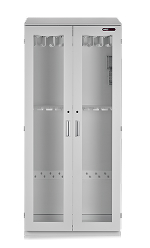
Constructed of durable metal with a special rust-proof coating
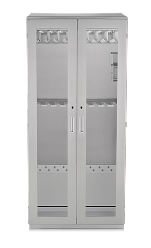
Constructed of non-porous,
rust-resistant stainless steel
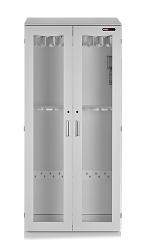
- Optimizes cabinet capacity utilization
- Holds up to 18 endoscopes
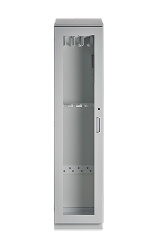
- Designed for small spaces
- Holds up to 8 endoscopes
Allows Hospital and Surgical facilities to connect facility compressed air to the ScopeLocker Air cabinet.
Provides a low-pressure HEPA-filtered air source that is integrated into some ScopeLocker Air Models.
Autoclavable Connectors
ScopeLocker Air connectors are compatible with most Olympus flexible GI scopes*, including colonoscopes, bronchoscopes, EUS scopes, duodenoscopes, gastroscopes, and enteroscopes. Each connection continually blows air through the endoscope channels.
Autoclavable Connectors
Flexible cleaning options now include autoclaving!
Quick Connect Air Manifolds
Connects endoscopes channels to filtered air source.
truConnect Clip
Features a simple squeeze-and-release mechanism enabling quick connections from endoscope channels to the air manifold.
Endoscope Capacity
Fits up to 18 endoscopes in one cabinet.
* See the IFU for compatibility.
Accessories
- KeylessEnt2DR: Electronic Keyless Entry for 18-scope cabinets (double-door)*
- KeylessENT1DR: Electronic Keyless Entry for 8-scope cabinets (single-door)*
- EUS Holder: Holder for EUS scopes*
- LockerLED: LED lighting for all ScopeLocker Air cabinets*
- LockerSensor: Optional hygrometer to measure temperature and humidity
- AIRSCOPEPADDING: Optional side padding designed to protect endoscope tips*
- SCOPELIFT: Insert used in J Hooks for EVIS X1™ endoscopy system and EDOF™ technology colonoscopes
*These accessories are built-into the cabinet during the manufacturing process. They must be ordered with the original cabinet order.
This cabinet is manufactured by CAPSA Healthcare.

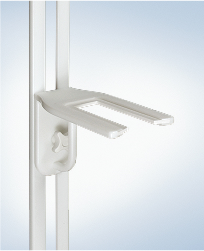
Find Out More
Complete the form below to learn more about the ScopeLocker Air drying cabinet.
- Kovaleva J. Endoscope drying and its pitfalls. J Hosp Infect. 2017;97:319-328.
- Endoscope Drying/Storage Cabinet: Interest and Efficacy, https://www.ncbi.nlm.nih.gov/pubmed/18055064
- AORN Guideline For Processing Flexible Endoscopes -Revised February 2016 for publication in Guidelines for Perioperative Practice, 2016 edition.
- Guideline for Disinfection and Sterilization in Healthcare Facilities, 2008. Centers for Disease Control and Prevention (page 16).
- Society of Gastroenterology Nurses and Associates, Inc. (SGNA) - Standards of Infection Prevention in Reprocessing of Flexible Gastrointestinal Endoscopes, 2023 ed.


































